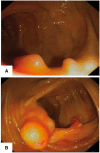Gastrointestinal complications induced by sevelamer crystals
- PMID: 28852493
- PMCID: PMC5570024
- DOI: 10.1093/ckj/sfx013
Gastrointestinal complications induced by sevelamer crystals
Abstract
Background: Sevelamer is a phosphate binder widely used in chronic kidney disease (CKD) patients. Sevelamer, as well as other resin-based binders, can crystallize leading to the formation of concretions. Sevelamer crystals (SC) have been associated with gastrointestinal (GI) mucosal injury. We describe three new cases of GI lesions associated with SC and review previously reported cases.
Methods: We describe three new cases of GI lesions associated with SC and review previously reported cases.
Results: We found 16 previously reported cases of SC-induced GI lesions. The mean patient age was 61 years (interquartile range 51.5-71.75), 62.5% were females and 10 patients were diabetic. In 13 cases, SC was found inside the GI mucosa. Six patients had history of major abdominal surgery. GI bleeding was the most common clinical symptom (n = 7), with three patients presenting with acute abdomen requiring surgical intervention. Although, SC-induced lesions were observed in all GI segments, intestine was involved in 81% of the cases. Endoscopic examination revealed mainly erosions and ulcerations (n = 7) and pseudoinflammatory polyps (n = 5). No association between sevelamer doses and the severity of GI lesions was found. However, diabetics patients seemed to develop GI lesions with smaller doses of sevelamer as compared with non-diabetic patients, in spite of their fewer GI comorbidities.
Conclusions: SC-induced GI lesions should be considered in CKD patients treated with sevelamer who present GI symptoms, especially lower GI bleeding, once other causes have been ruled out. Diabetics seem more prone to develop SC- associated GI lesions. Sevelamer therapy should be avoided if possible in patients with a history of major abdominal surgery or chronic constipation, because of the high risk of serious GI complications.
Keywords: chronic kidney disease; crystals; gastrointestinal lesions; hyperphosphataemia; sevelamer.
Figures


References
-
- Floege J. Phosphate binders in chronic kidney disease: a systematic review of recent data. J Nephrol 2016; 29: 329–40 - PubMed
LinkOut - more resources
Full Text Sources
Other Literature Sources

